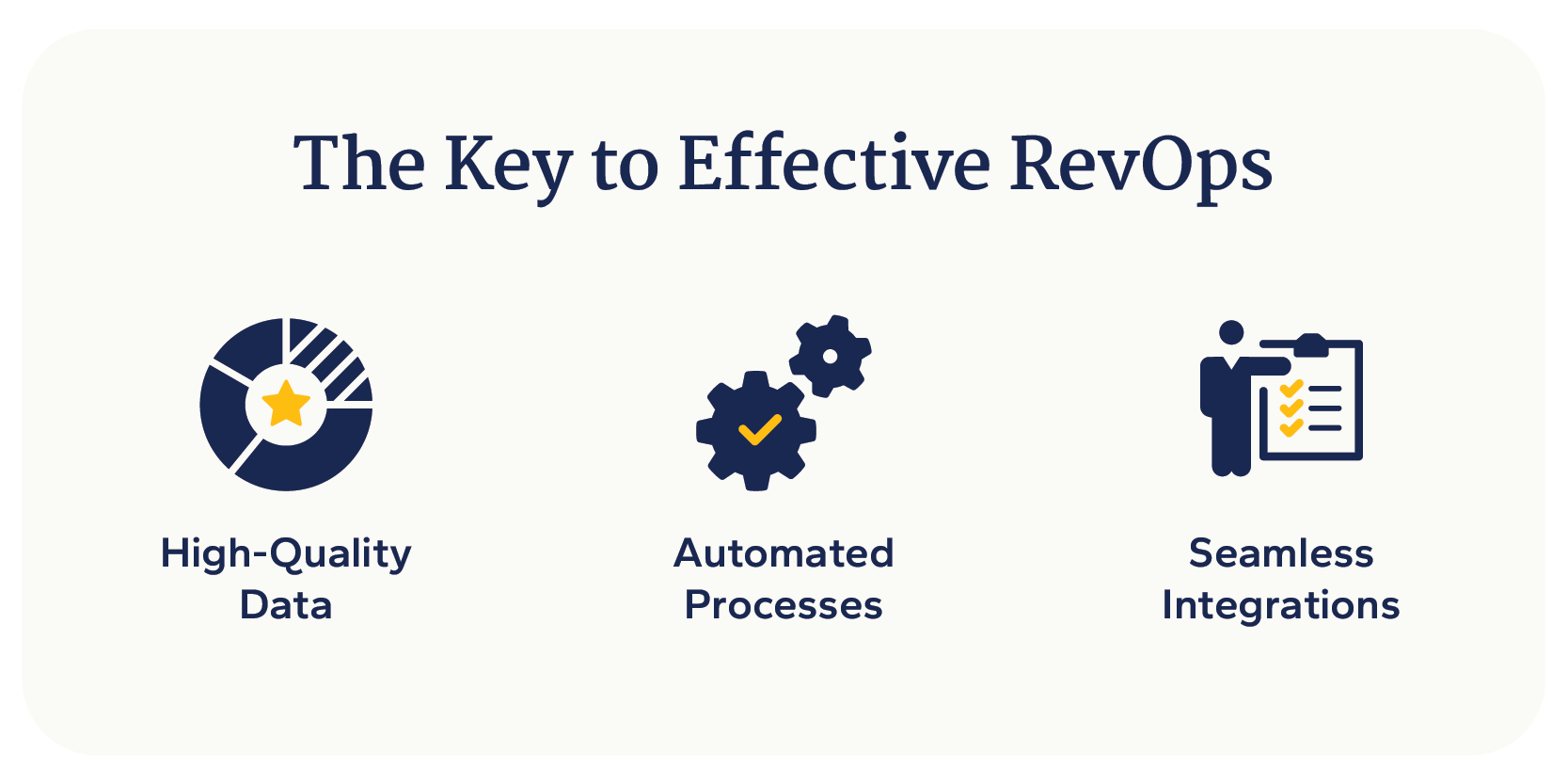Key Takeaways
- RevOps aligns sales, marketing, and customer service teams to improve efficiency, enhance customer satisfaction, and drive revenue growth, positioning it as a fundamental strategy for high-growth companies.
- Effective RevOps relies on high-quality data, automated processes, and seamless technology integrations to optimize operations and achieve business objectives.
- Implementing a RevOps model can transform an organization's operational efficiency, financial planning, and customer engagement, fostering a culture of data-driven decision-making and collaboration.
Alignment across all organizational functions is critical for growth, and revenue operations (RevOps) has emerged as a cornerstone strategy for forward-thinking companies. Gartner predicts that 75% of the world’s highest-growth companies will deploy a RevOps model by 2025.
RevOps represents a holistic approach to aligning sales, marketing, and customer service departments to drive revenue growth through increased efficiency and customer satisfaction. By breaking down traditional silos and fostering a culture of collaboration and data-driven decision-making, RevOps enables organizations to optimize their operations and achieve their business objectives more effectively.
The Key to Effective RevOps
The key to effective RevOps is creating a digital architecture that supports your business objectives and financial performance. You can build a scalable, user-friendly approach by focusing on your data, processes, and integrations.

-
High-Quality Data
The lifeblood of effective RevOps is high-quality data. Ensuring the accuracy, completeness, and timeliness of your data is paramount. Implementing robust data governance practices will help maintain data integrity. This includes routine data cleaning to remove inaccuracies and duplicates, validation to ensure data meets specific criteria and standards, and enrichment to enhance data from internal or external sources. High-quality data enables better decision-making and a more personalized customer experience.
Data must be accessible and transparent to all relevant departments to facilitate cross-functional analysis and decision-making. Implementing a centralized data storage solution, such as a cloud-based data warehouse, can provide teams across the organization with real-time access to critical business data.
-
Automated Processes
Automate repetitive and manual tasks where possible to increase efficiency and allow teams to focus on more strategic activities. For example, use automated workflows for lead nurturing in marketing or for service case routing in customer support.
Adopt a culture of continuous improvement by regularly reviewing and optimizing RevOps processes. Use metrics and feedback to identify bottlenecks or inefficiencies and apply lean principles to streamline operations, enhance productivity, and improve satisfaction throughout the customer lifecycle.
-
Seamless Integrations
Your technology stack, including ERP, CRM, marketing automation, and customer support platforms, should be tightly integrated to allow for seamless data flow. This ensures a unified view of the customer across all touchpoints, fostering better collaboration and enabling personalized customer experiences.
There is no one-tool-fits-all integration solution. Following your clearly defined business objectives can help you choose a tool and integration approach that will support your organization’s unique needs.
RevOps in Action: A Case Study
Building Zone Industries (BZI) is a leader in steel erection and fabrication. As a manufacturer and seller of steel support and machines for industrial construction, their innovative drive has revolutionized the steel construction industry. However, they recognized that their back-office business systems were holding them back.
After implementing their NetSuite financial management system, our team at Eide Bailly helped BZI create a digital ecosystem that allows for a streamlined, automated experience across the organization. By integrating the revenue cycle, BZI has seen better forecasting, job costing, and overall financial management.
"Eide Bailly has helped us increase our operational and financial efficiency exponentially."
— Silas Collentine, Systems Integration Specialist | BZI
How RevOps Impacts Operations
RevOps aligns sales, marketing, and customer service functions, significantly enhancing overall operational efficiency. It ensures that the growth vision and market responsiveness is uniformly implemented, making strategic objectives more attainable. RevOps brings operational cohesion and efficiency that enables smoother workflows, better resource allocation, and more effective execution of organization-wide strategies. This unified approach facilitates better decision-making, improves customer experiences, and fosters a culture of data-driven efficiency — critical components in driving sustainable growth and competitive advantage.
How RevOps Impacts Finance
RevOps empowers finance leaders by providing a holistic view of the revenue stream, enhancing forecast accuracy, and optimizing expenditure across departments. This integrated approach ensures that financial planning and analysis are grounded in comprehensive, real-time data, enabling finance leaders to make more informed decisions. By breaking down silos between sales, marketing, and customer service, RevOps fosters a collaborative environment that leads to a more efficient allocation of resources and a clearer understanding of how operational activities impact financial outcomes. This alignment is key to driving sustainable growth and profitability in a rapidly evolving market landscape.
How RevOps Impacts Marketing and Sales
RevOps models foster unprecedented alignment between marketing and sales teams, drastically improving lead generation, customer acquisition, and retention strategies. This model streamlines the handoff processes from marketing to sales, ensuring that leads are nurtured and followed up on more efficiently. Additionally, the shared data and insights help in crafting highly targeted campaigns and improving sales pitches, enhancing conversion rates and customer satisfaction. By breaking down silos, RevOps enables leaders to jointly focus on the company’s revenue goals, driving growth through a cohesive strategy that leverages the strengths of both departments.
Challenges in Implementing RevOps
Integrating technology can present several challenges, which, if not addressed, can hinder an organization's ability to streamline operations and achieve desired growth.
Data Silos
One of the most significant challenges is breaking down data silos within an organization. Sales, marketing, and customer service departments often use separate systems that don't naturally communicate with each other, making it difficult to have a unified view of the customer journey. This fragmentation can lead to inconsistent customer experiences and inefficiencies in internal processes.
Complexity and Cost
RevOps can be a lucrative investment with near-immediate measurable returns. But integration projects can become complex, requiring significant time and financial investment. There's always a risk that projects run over budget or fail to deliver the expected value. Organizations need to meticulously plan and manage these projects — particularly if managing them in-house — with clearly defined goals, timelines, and budgets. Working with an experienced and trusted partner can help mitigate these challenges.
How Eide Bailly Can Help
At Eide Bailly, we use our business acumen and technology expertise to help organizations create a sustainable digital roadmap. We will take the time to understand your business needs and build a solution that will support your organization for the long-term.
Leverage AI-Enhanced Integrations and Automations

Digital
Workato
Who We Are
Eide Bailly is a CPA firm bringing practical expertise in tax, audit, and advisory to help you perform, protect, and prosper with confidence.



